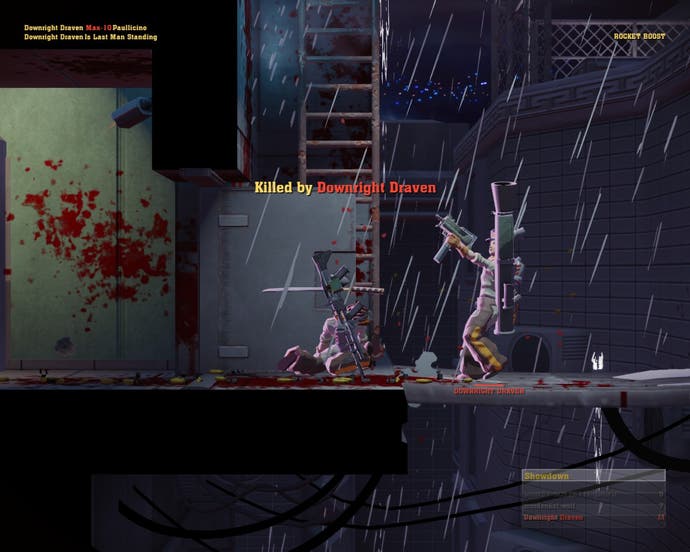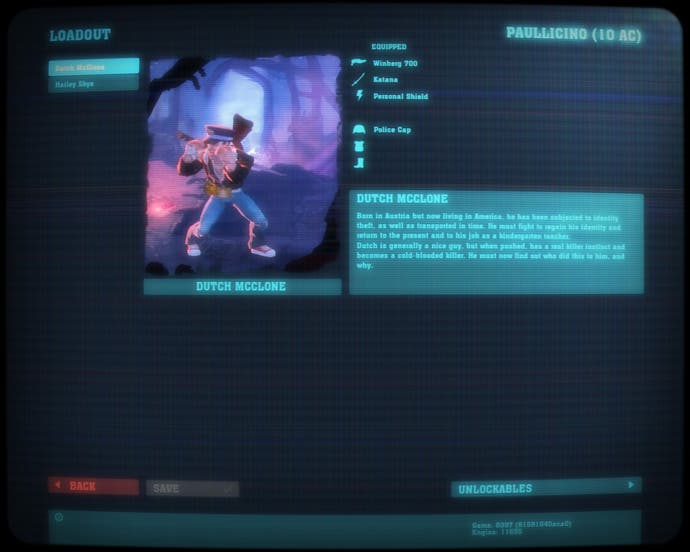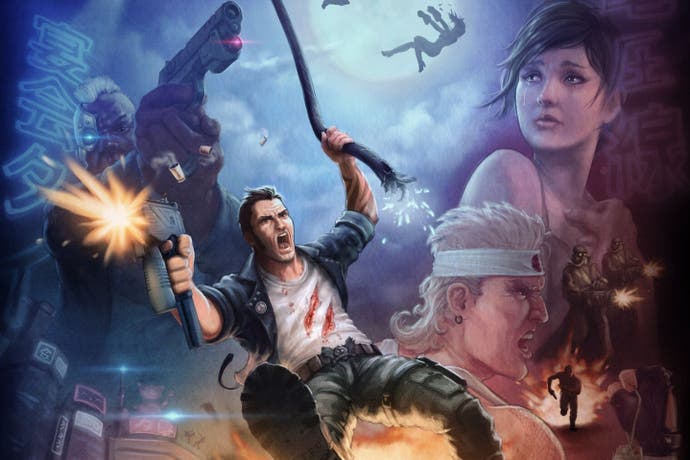The Showdown Effect preview: The last action hero
Arrowhead takes aim once again.
It's the middle of the afternoon and I've already fired a rocket launcher at a police officer, used a pizza box to block a hail of bullets and killed a man with a fire extinguisher (without even turning the thing on). During a lull in the fighting there's a muffled explosion above me somewhere and as debris rains down I try to grab anything that would work as an improvised weapon. It takes me a few seconds to realise why I can't pick up the item that fell at my feet: it used to be somebody's limb. Technically, I suppose it still is their limb, but the current state of things means I'm going to struggle to reunite it with its original owner and I'm not really sure what use they can make of it now. It quickly becomes irrelevant and after canvassing my environment I decide I'd be better off taking a frying pan and finding something (someone) I can swing it at.
This is how the middle of your afternoon looks if you're playing The Showdown Effect, anyway. Arrowhead Studios' second effort is a twitch-fast deathmatch platformer inspired by the likes of Super Smash Bros. and as riddled with action clichés as it is with bullets. Furthermore, it's as off-the-wall as you'd expect from a development team whose first game featured wizards with machineguns: Magicka was both inventive and irreverent, and Arrowhead's alchemy mixed a build-your-own system of spellcasting with tongue-in-cheek humour, selling over a million copies of the base game and some four million expansions to go with it.
It was also broken, as Dan Griliopoulos explained in his review, and though subsequent patches did much to address this, the memory of it's imperfect release remains fresh in Arrowhead's collective consciousness. This is not something they want to see repeated with The Showdown Effect, and lead designer Johan Pilestedt explains that getting the very best from their multiplayer melee demands thorough testing, something they say that publisher Paradox will guarantee this time around and, indeed, have to.

"If I was to say to a publisher that [a game] takes fifteen people twelve months to create and then you get these particular features, those are not negotiable," Pilestedt insists. "We can't say, 'Okay, we'll do it in ten months and keep the same features.' That's quality that you're scraping off." At first, he says, Arrowhead didn't realise how much time "vigilant" QA might require, but now its core to their development philosophy.
"I think it's unacceptable to release a product that is broken," Pilestedt explains. "If I were to go and buy a TV, I would expect to get a fully working TV and not one that works 70 per cent of the time."
Getting the balance of The Showdown Effect right matters because it's a game of timing and accuracy, a game where split-second reactions meet skull-splitting precision as players duck, dive, leap and slide their way through combat, mottling the walls around them with bullet holes and almost tearing the very air apart with katanas. As we talk, Pilestedt namechecks Quake as much as he does any platform game, and says players will have to be as sharp as they are quick. I can certainly confirm that, when battle is joined, death comes within seconds because combat is almost always extremely brief.
Quake aside, it's from the consoles of yesteryear that Arrowhead have drawn much of their influence for the game's controls and concepts. "Super Smash Bros. is the main inspiration for the melee combat. You can see that from the battles, where people are rolling around and trying to outpace each other, rolling past, blocking, trying to get an opening," Pilestedt says.
"Then the firearm mechanics have a bit of Goldeneye in there, primarily because you had to press down a button to get the crosshair and then you had to align the crosshair on top of the player to kill them. That was really, really difficult, but everybody had that same difficulty. Now we've got that thing in Showdown, but it's not that you have a hard time getting the cursor onto the player because the input is sluggish, rather that you're trying to get the cursor on the player while he's moving around like crazy."

It's this mix of melee weapons with firearms that's key to the Showdown experience. Neither is supposed to dominate the field of battle, but both have their place. Gunfighters try to keep their enemies at a distance while those who prefer close-quarters combat move in for the kill, something that Pilestedt compares to a Mace Windu/Jango Fett style face-off.
There's a sadist's selection of weaponry waiting to be tried, from giant wrenches to broken bottles to shotguns and sub-machineguns, and while many melee weapons prove to be surprisingly good at blocking bullets, the rocket launcher is still something to be avoided rather than deflected. Whatever weapons and character they've chosen, within 60 seconds of a game starting a mere handful of players can turn a level into a catalogue of carnage.
Then, after each fight, they walk away with in-game currency that they can spend on unlocking new weapons, equipment and characters, all of which they can mix and match. If you fancy taking a grizzled cop with a jetpack and a halberd into action against seven other similarly mismatched foes, this is certainly the game for you.
But, right now, that's about all The Showdown Effect is aiming for. It's not only quick and deadly, it's also over almost as soon as it begins, providing players little more than a fast and very frantic fix across a handful of largely static levels. This brevity suits its $9.99 price tag, which Pilestedt hopes will give the game a wider audience. "I'd rather have a million players playing at $9.99 than a third of that at $30. I want a lot of people to play the game because that's why I make games," he says, before quoting a famous pirate of days gone by. "I have one piece of advice, from one person, when it comes to pricing computer games, and that's Guybrush Threepwood: 'Never pay more than $20 for a computer game.'"

Of course, it's pretty much a given that both Arrowhead and Paradox will be keen to expand the game's scope much as they have with Magicka, providing more characters, weapons and backdrops through expansions and DLC. Pilestedt describes an idea for a more dynamic level involving characters jumping between moving hovercars, and adds that, while players won't be able to host levels they haven't purchased, they can still join friends who are playing with new content, even those new levels: "We'll take great care to never segregate the community by releasing map packs that punish people that don't buy things," he says.
I have a feeling that new content will be key to The Showdown Effect's lifespan and long-term appeal. Having only chalked up a few kills in the beta, I'm already starting to reach the limits of what this early release of the game can offer me. For all its precision, it's fundamentally a very lightweight game and I don't see the final release being very much more substantial. That said, for some of us those quick fixes will be quite satisfying, whether they're a couple of five-minute frenzies during our lunch hours or a team deathmatch before we take the trip home.
This is one I can't call yet, and I'm not alone either. Even Pilestedt isn't entirely sure how his game will be received. "Either Showdown's going to do really well because there's no game like it out there," he says, "or Showdown's going to do really badly because there's no game like it out there." He shrugs, I think, because however things turn out, he's still happy with what he's created and 50/50 is still way better odds than most action heroes ever get.

